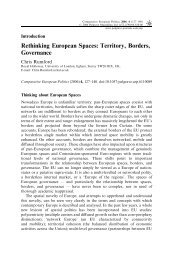Europeanisation, National Identities and Migration ... - europeanization
Europeanisation, National Identities and Migration ... - europeanization
Europeanisation, National Identities and Migration ... - europeanization
Create successful ePaper yourself
Turn your PDF publications into a flip-book with our unique Google optimized e-Paper software.
<strong>Migration</strong> <strong>and</strong> cultural diversification 107<br />
Pol<strong>and</strong> <strong>and</strong> other newly ‘opened’ societies of the region, where migratory inflows<br />
augment the spread of new, foreign religious movements <strong>and</strong> sects. In Polish society,<br />
thus far predominantly Catholic, these movements find their adherents, proving<br />
that importation of new ideas by the ‘addicted’ newcomers effectively diversifies<br />
life-styles <strong>and</strong> beliefs in the country. Another prominent example is provided by<br />
converts to Islam in some Western European societies. Research on Dutch female<br />
converts to Islam reveals that in the Netherl<strong>and</strong>s, in as early as 1993, the number<br />
of these women was estimated at between 3000 <strong>and</strong> 4000 (Nieuwkerk 2000: 2).<br />
While most of these women were first married to Muslim partners <strong>and</strong> then<br />
eventually converted to Islam, others ‘found their way to Islam <strong>and</strong> afterwards<br />
married Muslims’ (ibid.), <strong>and</strong> similar cases had been reported from Norway <strong>and</strong><br />
France. This conversion is very symptomatic. It occurs in the receiving states<br />
which contain substantial Muslim communities, proving that the neighbourhood,<br />
personal contacts, created interpersonal ties, <strong>and</strong> daily observed patterns of<br />
behaviour may effectively influence beliefs <strong>and</strong> change religious identity of some<br />
members of the host society.<br />
The two examples given show that new ideas imported by the newcomers both<br />
add to the existing cultural mosaic of ideas <strong>and</strong> values, diversifying the sphere of<br />
religion, <strong>and</strong> find their adherents among the indigenous society. The latter instance<br />
reveals a crucial fact, namely that ‘the symbolic importation’ may effectively<br />
compete with a set, traditional creed, <strong>and</strong> win over a number of its former followers.<br />
On the other h<strong>and</strong>, numerous conversions to Islam may prompt <strong>and</strong> augment the<br />
social discussion on the national creed <strong>and</strong> the uniqueness of European civilization,<br />
<strong>and</strong> compel individuals to rethink <strong>and</strong> reconsider their national <strong>and</strong> cultural identity<br />
vis-à-vis distant cultures. In other words, they may prompt the re-examination<br />
of both the collective <strong>and</strong> personal identity in the recipient society.<br />
As mentioned above, mass international inflows may well help the revival<br />
of forgotten or muted ideas, a good example here is racism. Intolerance towards<br />
the ‘other’ has a long tradition in Europe; nevertheless, it has been muted, <strong>and</strong><br />
disappeared from public life for decades after the Second World War. In recent<br />
decades, however, the negative image of the newcomers portrayed as ‘the alien<br />
dangerous invaders’ has seemed to increase significantly. Racism in contemporary<br />
Europe is taking on forms of ideologies, movements, <strong>and</strong> every-day practices,<br />
attitudes, <strong>and</strong> prejudice based on phenotypical, or cultural characteristics seen as<br />
fixed, naturalised <strong>and</strong> inherently different (Rath 1993: 231). Contacts between<br />
immigrants <strong>and</strong> the host society members enter into negative effect when attitudes<br />
<strong>and</strong> practices directed towards the newcomers are based on their phenotypical<br />
characteristics or cultural identity imposed upon them <strong>and</strong> then utilised as a<br />
marker of their inherent difference. The latter case, when the ‘immigrant-other’<br />
is considered as an inherently different <strong>and</strong> inferior ‘cultural being’, equates to<br />
‘cultural racism’ symptomatic of the ‘new’ or contemporary racism. The revival of<br />
these attitudes constitutes a disturbing <strong>and</strong> potentially explosive aspect of the<br />
ongoing cultural change in Western recipient countries (Romaniszyn 2001). The<br />
intensification of anti-foreign sentiments, intolerance, <strong>and</strong> xenophobia, which began<br />
in the 1980s <strong>and</strong> forms a part of cultural change seems to be an immediate



